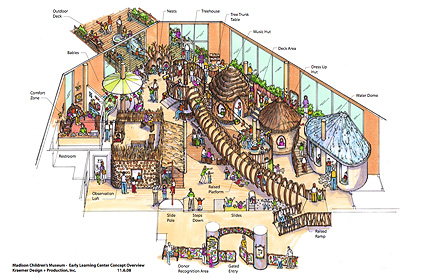Exhibits Case Studies
Madison Children's Museum100 State Street
Madison, WI 53703
608.251.6097 (p)
608.268.1398 (f)
John Robinson (contact)
jrobinson@madisonchildrensmuseum.org (e)
http://www.madisonchildrensmuseum.org
- Institutional Sustainability Mission
- Sustainability Guidelines for Contractors
- Learning from Leopold and Seuss, (pdf) Brenda Baker (Madison Children’s Museum), Guest Editor, Hand to Hand, volume 20, Spring 2006
- Seeing Green, (pdf) Jeremy Schoolfield, Fun World, The International Association of Amusement Parks & Attractions, June 2005
- "The Sustainable Museum: It's Not Easy Being Green," (pdf) Brenda Baker and John Robinson, Hand to Hand, volume 14, Winter 2000
Project Budget: $500,000
Exhibit/Project Description:
The Early Learning Gallery in MCM’s new location will be built entirely out of local, native and sustainably harvested materials found within 100 miles of Madison. In this space, young learners will be able to explore cause and effect phenomena, spatial relationships, shapes, patterns, gravity, measurement, properties of water, culture and literacy materials through activities that facilitate independence, encourage self-expression and foster their connection to the natural world.
Factors Affecting Decision to "Go Green":
Serving as this exhibit’s predecessor and inspiration, MCM’s First Feats was a revolutionary first attempt at creating a completely non-synthetic, sustainable play space for young children. Museum staff decided to take their pioneering work to the next level for the new early learning space, aided by the increased availability of materials, increased community support, and much broader acceptance of these methods throughout the museum field.
Distinguishing green features:
All wood used in this exhibit will be procured by local foresters and civic minded landowners, helping to showcase both native trees, and the local conservation ethic. Other features incorporated in this exhibit will include green printing techniques, organic fabrics, recycled glass, stone, and straw clay construction. Furthermore, mechanical fasteners used throughout will increase the museum’s ability to reuse exhibit components as they age and are retired or reconstructed.
Green products used:
- Sustainably harvested woods
- Local clay, made into tiles by elementary school students, to be used in the bathrooms
- Sustainably harvested flooring
- Local stone
- Wheat straw and clay for huts
- Cob
- Willow thatching
- Glass salvaged from building prior to reconstruction
- Habitat Restore salvage material incorporated into suspension bridge
Piece of advice for others regarding project:
Our communities are full of committed people that share our values and passion for sustainability. They are frequently eager to help with projects such as this. Many times it is just a matter of reaching out and letting them know there are ways they can help. Our work with the foresters in our area turned out to be a beneficial coincidence. Through this partnership we were able to get wood for free while also helping with the local conservation effort and building a joint sense of community.
New or Upcoming Green Projects:
Each of the three ‘green exhibits’ featured in MCM’s new building will explore a different aspect of sustainability: Local goods, material re-use and renewable energy, along with cultural sustainability throughout.


